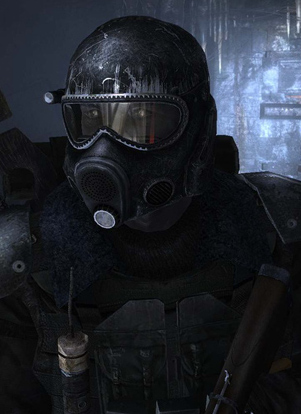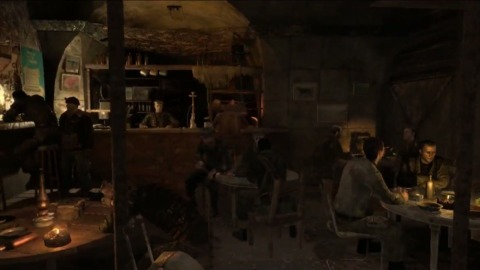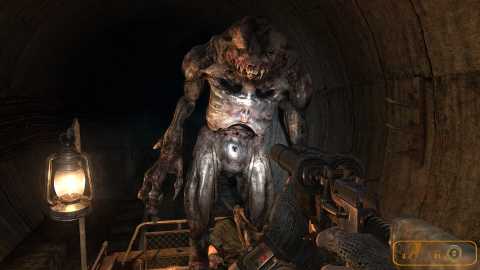Post-apocalyptic, zombie-infested wastelands are slowly becoming the new Normandy of video games. Such is the setup of the underground Moscow depicted in Metro 2033. Metro is the first game from Ukrainian developer 4A Games, a company founded by engineers from the S.T.A.L.K.E.R. team. While at first look you might expect a spiritual sequel to S.T.A.L.K.E.R. (there are even guitar-playing crooners to greet you at the campfire), Metro 2033 is a smaller, more focused game. It shares more in common with recent scripted shooters from the West than anything that's recently come out of the Eastern Bloc.

The story is told in a linear fashion that has Artyom (who weirdly only speaks through narrated loading screens) moving from town to town trying to find someone who understands the Dark Ones' threat and is willing to help out. Around half of the missions have you moving along your journey with whatever friendly soldiers happen across your path, though often you'll get separated and have to go through the cramped tunnels alone. It's in these moments that Metro 2033 successfully embraces its survival horror side with some keep-the-light-on stumbling that feels similar to the better parts of Doom 3. That's not to say that this is strictly a monster-closet scarefest, though, as Metro features quite a few clever puzzles and stealth elements. Be aware, though, if you aren't a fan of horror games, Metro 2033 likely isn't your game. Its HUD-free interface and visceral audio effects keep you focused on the action enough that you'll quickly learn to read Artyom's breathing patterns as a sign of trouble.
The well-done audio and lighting play a part in Metro 2033's stealth mechanics as well, which allow you to avoid detection and silently kill troops by keeping to the shadows or turning off the various lanterns that litter certain stealth-friendly levels. Unfortunately, while the sneaky parts of the game certainly work, it's not always consistent. I often found myself giving up on them entirely in favor of hunkering down and letting the enemies come to me. The stealth bits generally aren't up to the same standards as some of the better sneaker-shooter games (Deus Ex, Thief) and you might find yourself similarly frustrated with portions of the game.

Pristine bullets will also buy you new weapons, which are split between revolvers, shotguns, assault rifles, knives, and grenades. You can only hold one gun of any one type at a time, and most guns come in silent, scoped, or stopping power varieties. It's usually good to keep one of each type around, as most of the guns in Metro 2033 are ineffective at range. Actually, most of the guns don't carry much of a kick unless you specifically go for stealth or a headshot. With long weapon reload times that give Cryostasis a run for its money you'll find yourself doing a lot of running while you're reloading, which wouldn't be so bad, except that Metro 2033 features a lot of tight corridors without a lot of places to hide. In general, the weapons accurately fit the theme of the game, as you wouldn't expect to find a perfectly maintained AK-47 in the sewer muck that infests this version of Moscow.
The best gear in Metro 2033 is the gear worn on your head. You'll very quickly learn that you won't last long in the irradiated above-ground sequences without equipping a gas mask and will die just as quickly without night-vision goggles when underground. While your night-vision will drain its battery and need to be recharged, your gas mask (with replaceable filters) will take damage separate from your health. Take too much trauma and your mask will not only visibly scar but could crack, in which case you have all of 15 or so seconds to find a new one. While under the mask, the entire soundscape of Metro 2033 changes considerably. The voice of the comrade on your right is now coming in through your radio and all the echos of this watery world undergo a Barry White bass overdrive. In general, both effects are pulled off very well and really increase the believability of this scary, unhealthy place.

It's worth nothing that Metro 2033 is a single-player only affair and clocks in at around eight hours. So it's a pretty quick ride. There's very little reason to replay it unless you plan on going for many of the game's level-specific achievements. Technically the game does well enough on the 360, but in very specific lighting situations it's prone to framerate issues. Like other games that originate from Eastern Europe, the overall visual quality see-saws between stunning and silly on a texture-by-texture basis, but the audio, effects, and lighting are the clear winners here.
Metro 2033 successfully constructs a believable world that delivers a setting and story that get past the core annoyances of its gameplay. When you first watch steam escape from creaky 10-ton doors as they open to reveal the sprawling, murky madness of underground Moscow, you might be able to forgive the goofy monsters, too. Metro 2033 is best for experienced gamers already familiar with the trappings of the modern shooter who are OK with playing a roughly made game that still manages to deliver a unique experience.